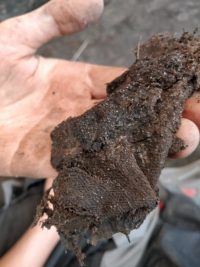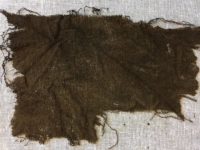Excavations in the historic center of Ribe, the oldest town in Denmark and the hub of maritime trade network that operated in the North and Baltic seas starting in the 7th century, unearthed a section of textile on July 25th of this year. It was preserved in water-logged soil and even folded up and coated in dirt the finely woven fabric was clearly identifiable as diamond twill.
This kind of high quality woolen cloth played an important role in the growth of trade in the area. In the early Middle Ages, cloth production was centered primarily in coastal areas where the sheep farms were. Southern Jutland, where Ribe was located, had a significant population of Frisians who specialized in creating wool fabric with an international reputation as the best in the business. Charlemagne gifted colorfully dyed Frisian wool cloaks to the Caliph of Baghdad and star of several One Thousand and One Nights Harun al-Rashid when he sent emissaries in 799 to offer friendship and alliance.
It’s a testament to how important the cloth was to the economy that early medieval codes imposed greater fines on people who harmed Frisian wool weavers. Only goldsmiths and harpers were granted the same distinction. The latter two professions were exclusively male. The weavers were largely women, so this law afforded them additional protections that other women did not enjoy.
Experts have been cleaning, conserving and studying the piece since it was discovered. They dated it to the first half of the 8th century, just a century after Ribe was settled. It is a z/z diamond twill woven on an A-frame loom with a thread count of 21 x 15 per centimeter. Researchers believe it’s a weave known as the Spong Hill type after the Anglo-Saxon cemetery type site where textile remains were found attached to brooches and other accessories. More research needs to be done to confirm the identification, to determine if it was dyed and find out other details about the piece.
But really it’s all about the before and after pictures.


It looks almost like someone used a scrap of material for an insole in a shoe or boot.
7th century or 8th century? Make up your mind. 😮
Fun fact: The stuff is referred to in Dutch as ‘Keper’, in German as ‘Köper’, in Danish as ‘Kiper’ and in Chech as ‘Kipr’, …
while in Russia it is твил (‘tvil’) and in Poland –for whatever reason– ‘Diagonal’.
However, an important role plays ‘Abul-Abbas’ the elephant [not to be confused with its former owner Abu al-Abbas al-Maʾmūn ibn Hārūn al-Rashīd], who was brought from Baghdad by a Frankish Jew named Isaac. Along with two other emissaries, Lantfrid and Sigimund, the aforementioned Isaac had been received by the caliph in 798.
In 801, Isaac as the only surviving member arrived at Pisa, i.e. with the elephant and two Abbasid emissaries. They were met by Charlemagne. One emissary was sent by the caliph ‘Aaron’ himself, the other one by Abraham (Ibrahim ibn al-Aghlab), governor of Africa. The emperor then ordered a man to Liguria to commission a fleet of ships to carry the elephant and other goods.
—————
[Anno 801] “…Ibi nuntiatur ei, legatos Aaron Amir al Mumminin regis Persarum portum Pisas intrasse. Quibus obviam mittens inter Vercellis et Eporeiam eos sibi fecit praesentari; unus enim ex eis erat Persa de Oriente, legatus regis Persarum, – nam duo fuerant – alter Sarracenus de Africa, legatus amirati Abraham, qui in confinio Africae in Fossato praesidebat. Qui Isaac Iudeum, quem imperator ante quadriennium ad regem Persarum cum Lantfrido et Sigimundo miserat, […] qua elefans et ea, quae cum eo deferebantur, subveherentur. ..”
—————
In 810, the emperor left his palace in Aachen and mounted a campaign intending to engage with King Godofrid of ..Denmark(!).. and his fleet that had invaded and plundered Friesland. They crossed the Rhine at a place called “Lippeham”, when ‘Abul-Abbas’ suddenly died (‘subita morte’) :skull:
—————
[810] “…deinde transmisso Rheno flumine in loco, qui Lippeham vocatur, copias, quae nondum convenerant, statuit operiri; ubi dum aliquot dies moraretur, elefans ille, quem ei Aaron rex Sarracenorum miserat, subita morte periit…”
—————
As if in the 5th century and earlier there were no sheep on the beaches… 😉
The Finnesburg- / ‘Finnsburh’ Fragment describes a battle in which Hnæf, a Danish prince, is attacked at a place called Finnsburuh “Finn’s stronghold”, the hall of Finn, ruler of the Frisians. The ‘Battle of Finnsburg’ was a conflict between Frisians with a possible Jutish contingent, and a Danish party. Described in later Anglo-Saxon poetry, if the conflict had a historical basis, it likely occurred around 450 AD.
:hattip:
——————–
..Þā gewāt him wund hæleðon wæg gangan,
sǣde þæt his byrneābrocen wǣre,
here-sceorpum hrōr,and ēac wæs his helm þyrl.
Þā hine sōna frægnfolces hyrde,
hū þā wīgendhyra wunda genǣson
oððe hwæðer þǣra hyssa . . . .
…Then wended away a wounded clansman,
said that his breastplate was broken sore,
his harness hewn, his helmet pierced.
Swiftly then asked the shepherd-of-folk
how the warriors all their wounds were bearing,
or which one, now, of the heroes twain…